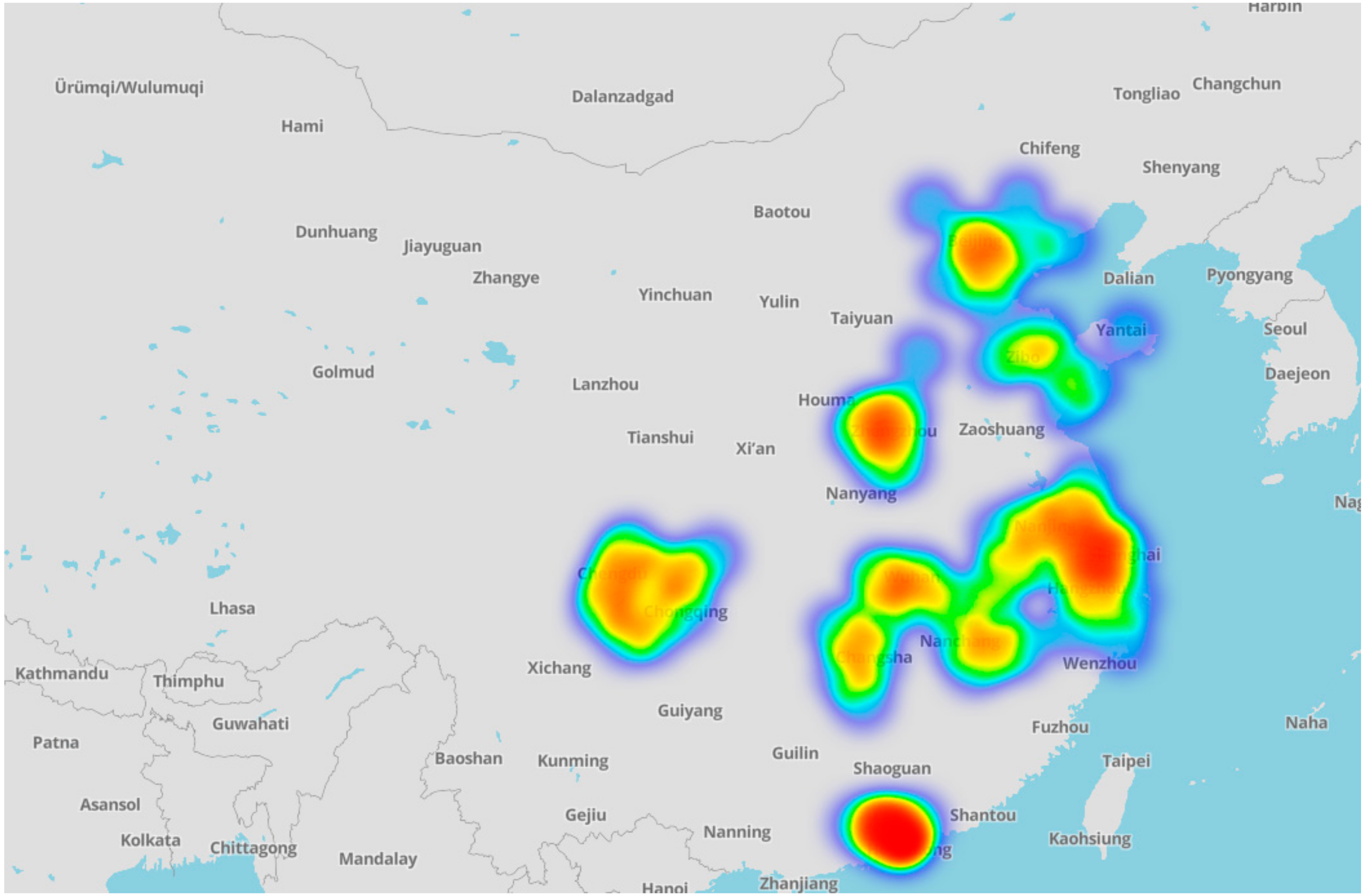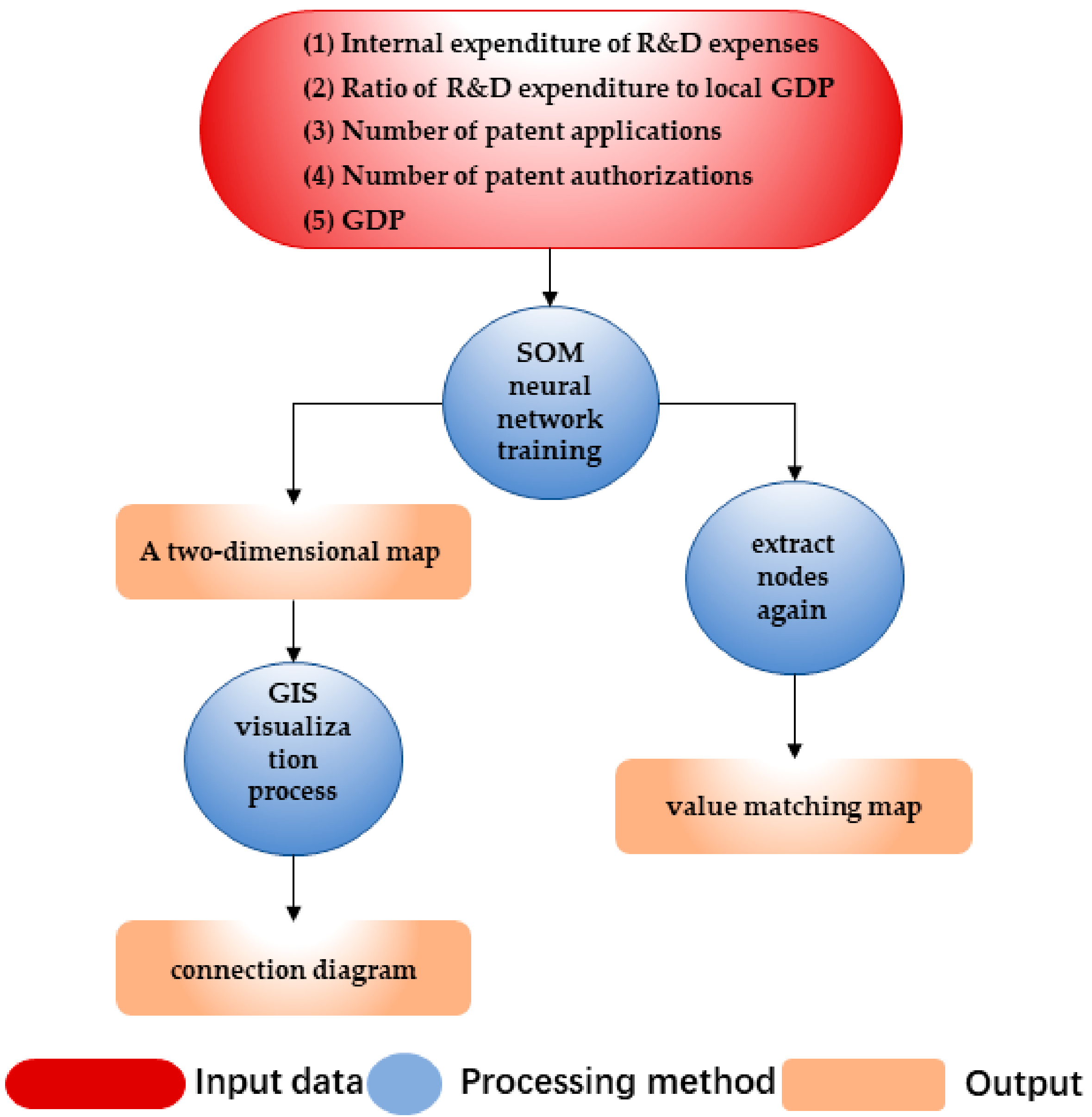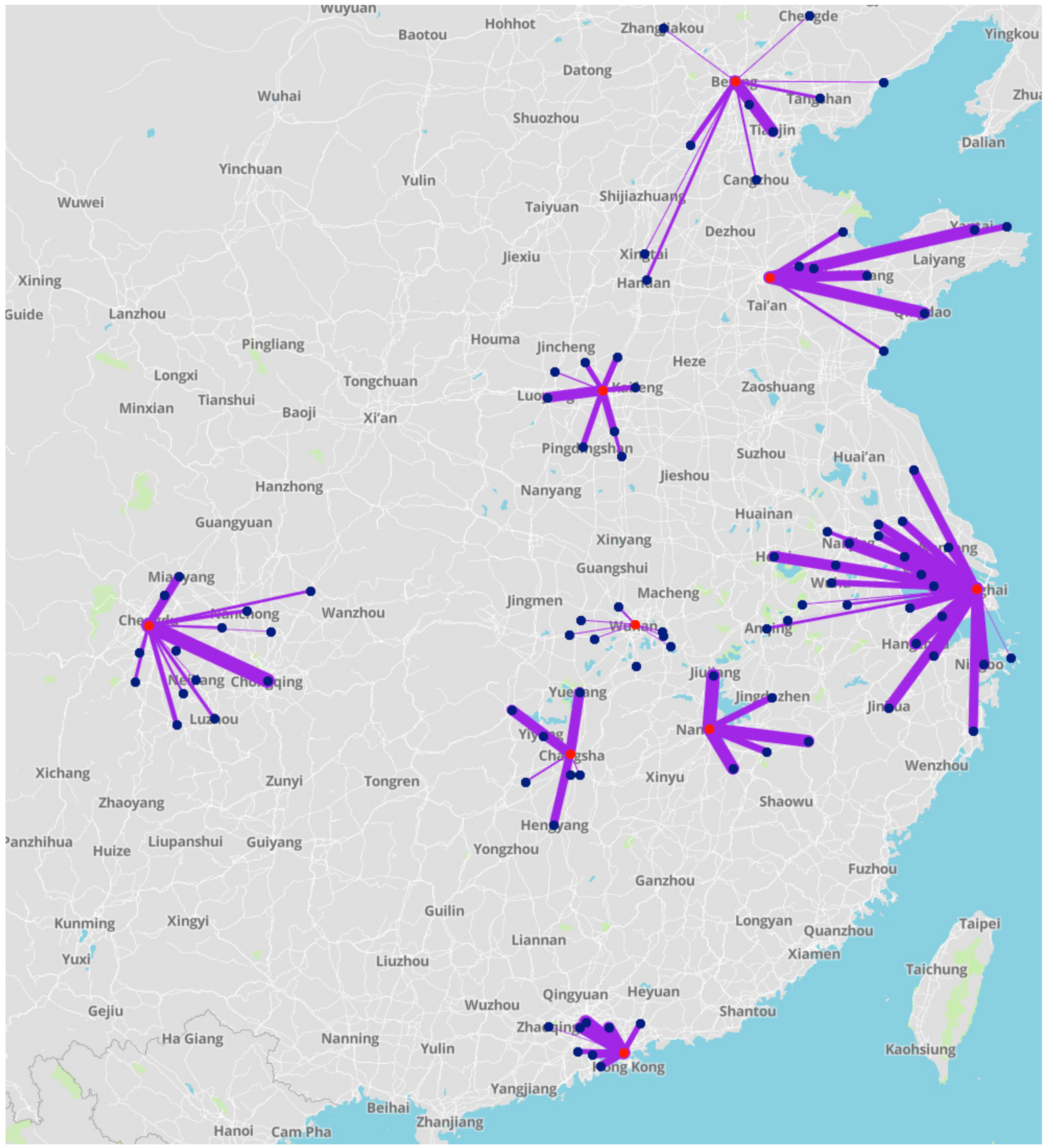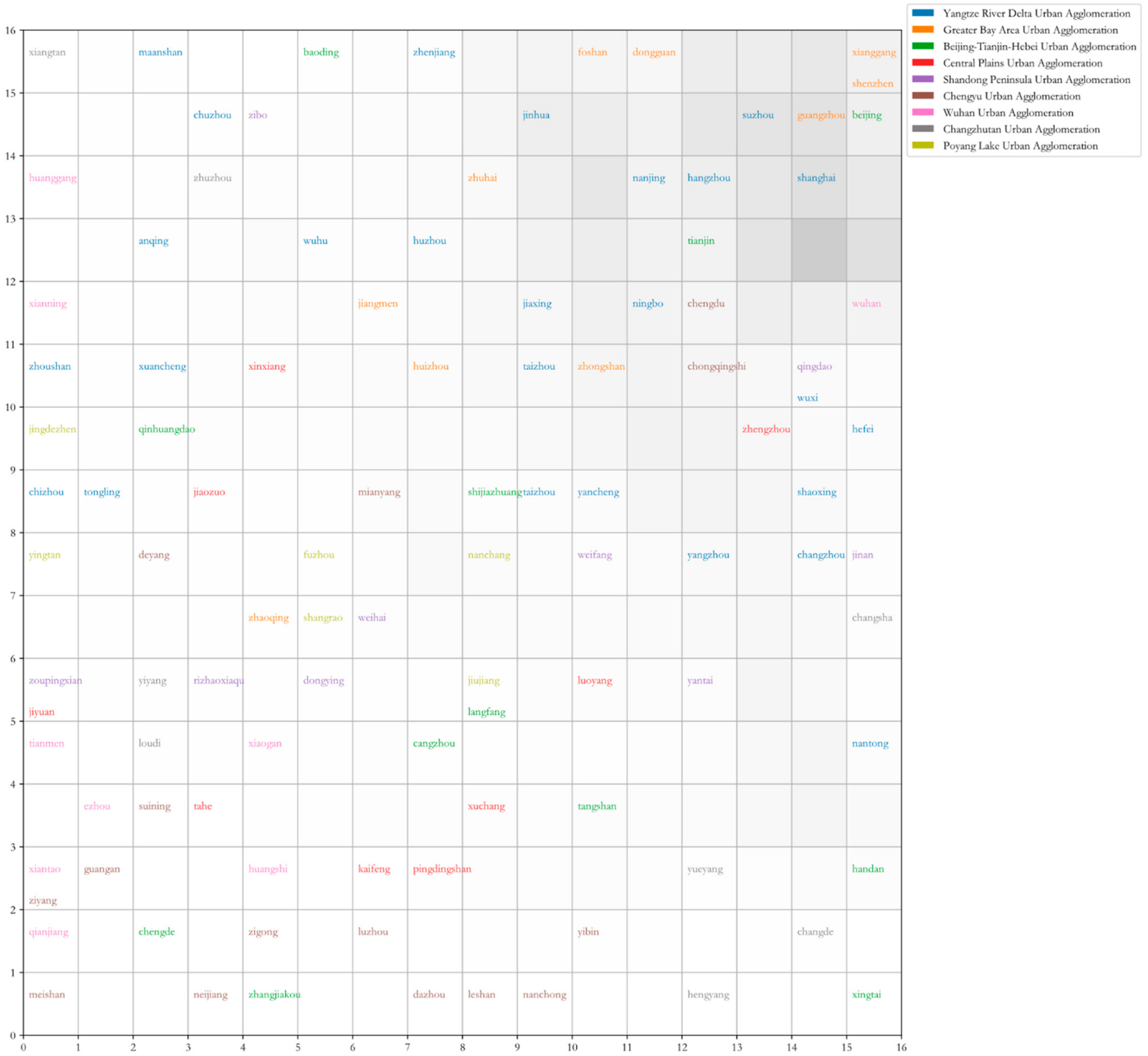Research on Innovation Non-Equilibrium of Chinese Urban Agglomeration Based on SOM Neural Network
Abstract
:1. Introduction
2. Literature Review
3. Research Methods and Results
3.1. Preliminary Analysis of the Current Situation of Innovation and Development of Chinese Urban Agglomeration
3.1.1. Definition of Urban Agglomeration
3.1.2. Number of Patent Applications and Authorizations
3.1.3. Patent Conversion Rate
3.2. Research on the Disequilibrium of Innovation and Development of Chinese Urban Agglomerations
3.2.1. Theil Index Method
3.2.2. Innovation Imbalance Based on the Gap in the Patent Conversion Rate of Urban Agglomerations
3.2.3. Self-Organizing Feature Map (SOM)
- (1)
- Assign a random value to the initial weight of each node in the output layer;
- (2)
- Input the sample vector to the input layer;
- (3)
- Calculate the victory neurons. First calculate the distance between each node of the output layer and the input sample vector:where represents the dimension of the input layer sample vector, is the sample vector of the step, and represents the weight between the input layer sample vector and the output layer node .Then choose the output node with the smallest distance as the winning node:
- (4)
- Update the weight. The formula is as follows:where is the learning rate of the step, which generally decreases linearly or exponentially as the training progresses, and is the neighborhood function, using the Gaussian nearest neighbor function.
- (5)
- Continue to the next step of training until the number of steps .
3.2.4. Five Basic Indicators for SOM Analysis
- (1)
- Internal expenditure of R&D expenses;
- (2)
- Ratio of R&D expenditure to local GDP;
- (3)
- Number of patent applications;
- (4)
- Number of patent authorizations;
- (5)
- GDP.
3.2.5. Data Processing
3.2.6. SOM Data Processing and GIS Visualization Processing
3.2.7. Extract Node Weights after SOM Data Processing
4. Results and Discussion
4.1. Results
4.1.1. Result Analysis of the Current Situation of Innovative Development of Urban Agglomeration
4.1.2. Analysis of the Research Results of the Theil Index Method
- (1)
- There is a significant innovation gap in China’s urban agglomerations as a whole; that is, regional innovation capabilities are not balanced.
- (2)
- The innovation gap between different agglomerations within China’s urban agglomerations is relatively small; that is, the gap in the innovation development level of different urban agglomerations is relatively small.
- (3)
- The innovation gap within each urban agglomeration is relatively large, and larger than the innovation gap between different urban agglomerations; that is, the imbalance of innovation development within urban agglomerations is greater than the imbalance of innovation development among urban agglomerations.
4.1.3. SOM Method Research Results
4.2. Discussion
- (1)
- Central cities, such as Beijing, Shanghai, Guangzhou, and Shenzhen; municipalities directly under the Central Government; and provincial capitals, have long gathered a large quantity of talents and resources. These urban areas have accumulated innovation ability and experience over a long period; as a result, it is difficult for surrounding small cities to catch up. In addition, according to the principles of the market economy, in response to the profit motive, talented individuals move from surrounding cities to the central city, which further exacerbates the innovation gap within urban agglomerations. This is the major reason why the imbalance in innovation development within urban agglomerations is greater than that between urban agglomerations. This also explains the small internal innovation gap of the Poyang Lake urban agglomeration, which does not have large cities, whereas the Wuhan urban agglomeration, which is centered on a large city, has a large internal innovation gap.
- (2)
- The innovation gap in urban agglomerations with strict administrative standards is even greater. This can be verified by the Beijing–Tianjin–Hebei urban agglomeration. Based on the analysis of the internal innovation connection diagram (Figure 3), the Beijing–Tianjin–Hebei urban agglomeration has applied for urban patents. The large gap in quantity is related to the stricter administrative standard of the development plans in the Beijing–Tianjin–Hebei region. Due to the resource allocation method of “strong government, weak market”, the policy gradient gap in the region is obvious, and results in significantly greater innovation resources in Beijing and Tianjin than in the surrounding cities and, therefore, a wider gap. On the contrary, the innovation difference in cities within the urban agglomeration of the Guangdong–Hong Kong–Macao Greater Bay Area, which operates according to “strong market, weak government”, is smaller.
- (3)
- Collaborative innovation development between regions will help narrow the innovation gap between cities. According to the central city theory explained in the first point, the innovation gap between cities in the Yangtze River Delta urban agglomeration, with Shanghai as the center, should be relatively large. However, the internal innovation gap of the Yangtze River Delta clusters is relatively small. The development of collaborative innovation among cities occurs within the triangle urban agglomeration. The Yangtze River Delta urban agglomeration has a more reasonable “center-periphery” gradient structure than other urban agglomerations. The relationship between Shanghai and surrounding cities is no longer an antagonistic and resource-competing relationship, but a mutually cooperative relationship. Through the reasonable division of labor and cooperation, the inner cities of the Yangtze River Delta urban agglomeration have formed a close community of interests. This will help reduce the innovation gap between internal cities and promote the collaborative development of innovation among these cities.
5. Conclusions
- (1)
- The hierarchical differentiation of the innovation development of China’s urban agglomerations is becoming increasingly clear, and there is a significant innovation gap overall. The problem of the imbalance in regional innovation development is pronounced; that is, regional innovation capabilities are not balanced.
- (2)
- The innovation gap between different urban agglomerations in China is relatively small; that is, the gap in the level of innovation and development of different urban agglomerations is relatively small.
- (3)
- The innovation gap between cities within each urban agglomeration is relatively large, and is significantly larger than the innovation gap between different urban agglomerations; that is, the imbalance in innovation development within urban agglomerations is greater than the imbalance in innovation development among urban agglomerations.
- (4)
- Central cities in urban agglomerations may squeeze the innovation resources of surrounding cities, leading to a widening in the innovation gap between cities. The irrational allocation of innovation resources in urban agglomerations with strong administrative standards will also further aggravate this gap. The coordinated development of innovation between regions can help narrow the innovation gap between cities.
Author Contributions
Funding
Data Availability Statement
Conflicts of Interest
References
- Wang, C.Z.; Zhao, G.J. Analysis of China’s regional innovation efficiency based on non-radial SE-C~2R model and pedigree clustering. China Soft Sci. 2015, 11, 68–80. [Google Scholar]
- Zhang, A.; Zhang, Y.; Zhao, R. A Study of the R&D Efficiency and Productivity of Chinese Firms. J. Comp. Econ. 2003, 31, 444–464. [Google Scholar] [CrossRef]
- Agbali, M.; Trillo, C.; Fernando, T.P.; Arayici, Y. Creating Smart and Healthy Cities by Exploring the Potentials of Emerging Technologies and Social Innovation for Urban Efficiency: Lessons from the Innovative City of Boston. Int. J. Civ. Environ. Struct. Constr. Archit. Eng. 2017, 11, 600–610. [Google Scholar]
- Ben, T.M.; Wang, K.F. Interaction Analysis among Industrial Parks, Innovation Input, and Urban Production Efficiency. Asian Soc. Sci. 2011, 7, 56–71. [Google Scholar] [CrossRef]
- Cooke, P. Regional Innovation Systems, Clusters, and the Knowledge Economy. Ind. Corp. Chang. 2001, 10, 945–974. [Google Scholar] [CrossRef]
- Villani, E.; Lechner, C. How to acquire legitimacy and become a player in a regional innovation ecosystem? The case of a young university. J. Technol. Transf. 2020, 4, 1–29. [Google Scholar] [CrossRef]
- Mao, Q.L.; Xu, J.Y. Market transformation, Employment dynamics and productivity growth in China. Manag. World. 2015, 10, 7–23 + 87. [Google Scholar]
- Cheng, Q.; Yin, Z.F.; Ye, J.Y. State-owned Enterprises and Regional Innovation Efficiency-Based on the Perspective of Externality Analysis. Ind. Econ. Res. 2015, 4, 10–20. [Google Scholar]
- Zhang, C.Z.; Huang, D.C.; Ma, Z.J. Industrial Agglomeration and Industrial Innovation Efficiency: The Connection and Promotion of Financial Market-Taking High-tech Industrial Agglomeration and Innovation as an Example. Ind. Econ. Res. 2012, 6, 17–25. [Google Scholar]
- Bai, J.h.; Jiang, F.X. A Study on Regional Innovation Efficiency Considering Environmental Factors—Based on the Three-stage DEA Method. Financ. Trade Econ. 2011, 10, 104–112+136. [Google Scholar]
- Zhou, X.Y.; Ge, J.; Ma, L.Y. An Empirical Study on the Efficiency of China’s Regional Innovation System Based on Dynamic Panel Data Mode. Econ. Manag. 2009, 31, 28–32. [Google Scholar]
- Jefferson, G.H.; Huamao, B.; Xiaojing, G.; Xiaoyun, Y. R&D Performance in Chinese Industry. Econ. Innov. New Technol. 2006, 15, 345–366. [Google Scholar]
- Nasierowski, W.; Arcelus, F.J. On the efficiency of national innovation systems. Socio Econ. Plan. Sci. 2003, 37, 215–234. [Google Scholar] [CrossRef]
- Narula, R.; Dunning, J.H. Industrial Development, Globalization and Multinational Enterprises: New Realities for Developing Countries. Oxf. Dev. Stud. 2000, 28, 141–167. [Google Scholar] [CrossRef]
- Hong, J.; Feng, B.; Wu, Y.R.; Wang, L. Do government grants promote innovation efficiency in China’s high-tech industries? Technovation 2006, 57, 4–13. [Google Scholar] [CrossRef]
- Wang, Q.; Yang, R.; Zhao, R.Y.; Wang, C. Does State-level Upgrade of High-tech Zones Promote Urban Innovation Efficiency: Evidence from China. Sustainability 2019, 11, 6071. [Google Scholar] [CrossRef] [Green Version]
- Mora, L.; Bolici, R.; Deakin, M. The First Two Decades of Smart-City Research: A Bibliometric Analysis. J. Urban Technol. 2017, 24, 3–27. [Google Scholar] [CrossRef]
- Nam, T.; Pardo, T.A. Smart city as urban innovation: Focusing on management, policy, and context. In Proceedings of the 5th International Conference on Theory and Practice of Electronic Governance ICEGOV ’11, Tallinn, Estonia, 26–29 September 2011; Association for Computing Machinery: New York, NY, USA, 2011; Volume 9, pp. 185–194. [Google Scholar] [CrossRef]
- Caragliu, A.; Bo, D.C.F. Smart innovative cities: The impact of Smart City policies on urban innovation. Technol. Forecast. Soc. Chang. 2019, 142, 373–383. [Google Scholar] [CrossRef]
- Berry, B.J.L.; Okulicz-Kozaryn, A. The city size distribution debate: Resolution for US urban regions and megalopolitan areas. Cities 2012, 29, S17–S23. [Google Scholar] [CrossRef]
- Bulkeley, H.; Coenen, L.; Frantzeskaki, N.; Hartmann, C.; Kronsell, A.; Mai, L.; Marvin, S.; McCormick, K.; van Steenbergen, F.; Palgan, Y.V. Urban living labs: Governing urban sustainability transitions. Curr. Opin. Environ. Sustain. 2016, 22, 13–17. [Google Scholar] [CrossRef] [Green Version]
- Bibri, S.E. A foundational framework for smart sustainable city development: Theoretical, disciplinary, and discursive dimensions and their synergies. Sustain. Cities Soc. 2017, 38, 758–794. [Google Scholar] [CrossRef]
- Datta, A. New urban utopias of postcolonial India: ‘Entrepreneurial urbanization’ in Dholera smart city, Gujarat. Dialogues Hum. Geogr. 2015, 5, 3–22. [Google Scholar] [CrossRef]
- Powson, E. Megalopolis: The urbanized northeastern seaboard of the United States. Prog. Hum. Geog. 2008, 32, 441–444. [Google Scholar]
- Spivak, A.A.; Loktev, D.N.; Rybnov, Y.S.; Soloviev, S.P.; Kharlamov, V.A. Geophysical fields of a megalopolis. Izv. Atmos. Ocean. Phys. 2016, 52, 841–852. [Google Scholar] [CrossRef]
- Gutiérrez-Avila, I.; Arfer, K.B.; Wong, S.; Rush, J.; Kloog, I.; Just, A.C. A spatiotemporal reconstruction of daily ambient temperature using satellite data in the Megalopolis of Central Mexico from 2003 to 2019. Int. J. Climatol. 2021, 41, 4095–4111. [Google Scholar] [CrossRef] [PubMed]
- Ebel, R. Chinampas: An Urban Farming Model of the Aztecs and a Potential Solution for Modern Megalopolis. Horttechnology 2020, 30, 13–19. [Google Scholar] [CrossRef] [Green Version]
- Terando, A.J.; Costanza, J.; Belyea, C.; Dunn, R.R.; McKerrow, A.; Collazo, J.A. The Southern Megalopolis: Using the Past to Predict the Future of Urban Sprawl in the Southeast U.S. PLoS ONE 2014, 9, e102261. [Google Scholar] [CrossRef] [Green Version]
- Lang, R.E.; Knox, P.K. The New Metropolis: Rethinking Megalopolis. Reg. Stud. 2009, 43, 789–802. [Google Scholar] [CrossRef]
- Porfiryev, B.N.; Bobylev, S.N. Cities and Megalopolises: The Problem of Definitions and Sustainable Development Indicators. Stud. Russ. Econ. Dev. 2018, 29, 116–123. [Google Scholar] [CrossRef]
- Fang, C.L.; Yu, D.L. Urban agglomeration: An evolving concept of an emerging phenomenon. Landsc. Urban Plan. 2017, 162, 126–136. [Google Scholar] [CrossRef]
- Chen, D.L.; Lu, X.H.; Kuang, B. Dynamic evolution and spatial convergence of urban land use efficiency in the urban agglomeration in the middle reaches of the Yangtze River. Chin. Popul. Resour. Environ. 2018, 28, 106–114. [Google Scholar]
- Yu, J.K.; Ma, J.Q. Study on the evolution of the spatial pattern of economic linkages in the Shandong Peninsula urban agglomeration. Geogr. Sci. 2018, 38, 1875–1882. [Google Scholar]
- Zhang, H.; Jiang, F.; Wang, Y.Q.; Cheng, J.H.; Qian, C. The temporal and spatial differences and distribution characteristics of the ecological livability and industry level of the Yangtze River Delta urban agglomeration. Chin. Popul. Resour. Environ. 2018, 28, 73–82. [Google Scholar]
- Wang, Q.; Jin, C. A Quantitative Measurement of the Unbalanced Economic Development Level of China’s Urban Agglomerations. Quant. Econ. Tech. Econ. Res. 2018, 35, 77–94. [Google Scholar]
- Liu, Y.Q.; Quan, Q.; Zhu, J.L.; Wang, F. Green Technological Innovation, Industrial Agglomeration and Ecological Efficiency: Taking the Urban Agglomeration of the Yangtze River Economic Belt as an Example. Resour. Environ. Yangtze River Basin 2018, 27, 2395–2406. [Google Scholar]
- Liu, S.L. The development process and future vision of China’s urban agglomerations since the reform and opening up. Gansu Soc. Sci. 2018, 5, 1–9. [Google Scholar]
- Chen, G.L.; Tang, G.N. Research on the Spatial Disintegration of the Secondary and Tertiary Industries Based on the Internet Perspective—Empirical Evidence from the Yangtze River Delta City Group. China Ind. Econ. 2016, 8, 76–92. [Google Scholar]
- Fan, F.; Lian, H.; Liu, X.Y.; Wang, X.L. Can environmental regulation promote urban green innovation Efficiency? An empirical study based on Chinese cities. J. Clean. Prod. 2020, 287, 125060. [Google Scholar] [CrossRef]
- Zhang, J.X.; Kang, L.; Li, H.; Ballesteros-Pérezt, P.; Zuo, J. The impact of environmental regulations on urban Green innovation efficiency: The case of Xi’an. Sustain. Cities Soc. 2020, 57, 102123. [Google Scholar] [CrossRef]
- Zhou, C.; Zeng, G.; Cao, X.Z. Study on the network structure and innovation ability of Chinese cities. Geogr. Research 2017, 36, 1297–1308. [Google Scholar]
- Feng, F.; Wang, L.B. Research on the improvement of regional science and technology policy performance from the perspective of collaborative innovation—Based on the empirical analysis of the Pan-Yangtze River Delta region. Sci. Sci. Manag. S. T. 2011, 12, 109–115. [Google Scholar]
- Guoping, L. Research on the integrated development policy of science and technology innovation in the Beijing-Tianjin-Hebei region. Econ. Manag. 2014, 6, 13–18. [Google Scholar]
- Li, Y.C.; Phelps, N. Megalopolis unbound: Knowledge collaboration and functional polycentricity within and beyond the Yangtze River Delta Region in China, 2014. Urban Stud. 2016, 5, 443–460. [Google Scholar] [CrossRef]
- Tomokiyo, M.T.; Hurst, M. A Language Model Approach to Keyphrase Extraction. Assoc. Comput. Linguist. 2003, 6, 33–40. [Google Scholar] [CrossRef] [Green Version]
- Li, B.; Tian, X.L.; Zhang, S.D.; Zhao, H.P. Research on the evaluation of urban innovation ability and the evolution of spatial-temporal pattern. Math. Stat. Manag. 2020, 39, 139–153. [Google Scholar]
- Haščič, I.; Migotto, M. Measuring Environmental Innovation Using Patent Data; Paris OECD: Paris, France, 2015. [Google Scholar]
- Deng, Y.W.; Hu, T.; Hou, J.J.; Zhang, M.L. Study on the Spatial Differentiation of Urban Innovation Ability in Changchun Metropolitan Area. Planner 2020, 36, 69–74. [Google Scholar]
- Zeng, J.Y.; Liu, Y.; Wang, R.Y.; Zhan, P.Y. Absorptive capacity and regional innovation in China: An analysis of patent applications, 2000–2015. Appl. Spat. Anal. Policy 2019, 12, 1031–1049. [Google Scholar] [CrossRef]
- Xie, S.H.; Gan, C.; Yu, H.Y. Evaluation of the Innovation Ability of the Yangtze River Delta Urban Agglomeration and Analysis of Its Spatial Differences. Urban Issues 2017, 8, 92–95+103. [Google Scholar]
- Zheng, Y.; Qin, K.X. Performance evaluation and temporal-spatial differences of ecological innovation in China’s provincial capitals: An empirical analysis since the implementation of innovation-driven development strategies. Technol. Prog. Countermeas. 2021, 1, 36–44. [Google Scholar]
- Feng, Y.T.; Zhai, J.T.; Ji, L.Q. Innovative ability, economic structure and the rise and fall of cities. Res. Financ. Issues 2019, 423, 115–123. [Google Scholar]
- Wu, M.; Liu, Z.J. Evaluation index system construction and empirical analysis of innovation oriented city. Sci. Technol. Econ. 2009, 22, 14–17. [Google Scholar]
- Liu, M.G.; Li, G.Y. Comparative research of typical innovation index compilation method at domestic and abroad. Int. Conf. Inf. Manag. IEEE 2017, 3, 447–452. [Google Scholar] [CrossRef]
- Zhou, Z.H. On the city’s comprehensive innovation ability. Shanghai Econ. Res. 2002, 4, 23–24. [Google Scholar]






| Urban Agglomerations | Cities under the Urban Agglomerations |
|---|---|
| Yangtze River Delta Urban Agglomeration | Shanghai, Nanjing, Wuxi, Changzhou, Suzhou, Nantong, Yancheng, Yangzhou, Zhenjiang, Taizhou in Jiangsu Province, Hangzhou, Ningbo, Jiaxing, Huzhou, Shaoxing, Jinhua, Zhoushan, Taizhou in Zhejiang Province, Hefei, Wuhu, Ma’anshan, Tongling, Anqing, Chuzhou, Chizhou, Xuancheng in Anhui Province |
| Guangdong–Hong Kong–Macao Greater Bay Area Urban Agglomeration | Guangzhou, Shenzhen, Zhuhai, Foshan, Dongguan, Huizhou, Zhongshan, Jiangmen, Zhaoqing, Hong Kong, Macau |
| Beijing–Tianjin–Hebei Urban Agglomeration | Beijing, Tianjin, Baoding, Tangshan, Langfang, Shijiazhuang, Qinhuangdao, Zhangjiakou, Chengde, Cangzhou, Xingtai, Handan in Hebei Province |
| Central Plains Urban Agglomeration | Zhengzhou, Kaifeng, Luoyang, Xinxiang, Pingdingshan, Xuchang, Jiaozuo, Luohe and Jiyuan in Henan Province |
| Shandong Peninsula Urban Agglomeration | Jinan, Qingdao, Zibo, Weifang, Dongying, Yantai, Weihai, Rizhao and Zouping counties in Shandong Province |
| Chengyu Urban Agglomeration | Chongqing City, Chengdu, Mianyang, Deyang, Leshan, Meishan, Suining, Neijiang, Nanchong, Ziyang, Zigong, Yibin, Guang’an, Dazhou, Luzhou in Sichuan Province |
| Wuhan Urban Agglomeration | Centered on Wuhan, the largest city in the central region, it covers an urban agglomeration composed of 8 large and medium-sized cities around Huangshi, Ezhou, Huanggang, Xiaogan, Xianning, Xiantao, Qianjiang, Tianmen, etc. |
| Changzhutan Urban Agglomeration | Hunan Province: Parts of eastern and central Hunan centered on Changsha, Zhuzhou, Xiangtan, Hengyang, Yueyang, Yiyang, Changde, and Loudi |
| Poyang Lake Urban Agglomeration | Nanchang, Jiujiang, Shangrao, Fuzhou, Jingdezhen, and Yingtan in Jiangxi Province |
| Urban Agglomerations in China | Number of Cities | Average Value of Patent Applications | Rank | Average Value of Patents Authorized | Rank | Rank | |
|---|---|---|---|---|---|---|---|
| Yangtze River Delta Urban Agglomeration | 26 | 46241.577 | 1 | 26124.192 | 1 | 0.564 | 7 |
| Guangdong-Hong Kong-Macao Greater Bay Area Urban Agglomeration | 11 | 35977.600 | 2 | 21046.253 | 2 | 0.585 | 4 |
| Beijing-Tianjin-Hebei Urban Agglomeration | 12 | 34474.000 | 3 | 20096.750 | 3 | 0.583 | 5 |
| Central Plains Urban Agglomeration | 9 | 12184.889 | 6 | 7323.778 | 6 | 0.601 | 3 |
| Shandong Peninsula Urban Agglomeration | 9 | 21041.667 | 4 | 11891.000 | 4 | 0.565 | 6 |
| Chengyu Urban Agglomeration | 15 | 12646.067 | 5 | 7963.600 | 5 | 0.630 | 2 |
| Wuhan Urban Agglomeration | 9 | 11221.778 | 7 | 5722.556 | 7 | 0.510 | 9 |
| Changzhutan Urban Agglomeration | 8 | 9912.125 | 8 | 5313.000 | 9 | 0.536 | 8 |
| Poyang Lake Urban Agglomeration | 6 | 8726.667 | 9 | 5663.000 | 8 | 0.649 | 1 |
| average value | 105 | 21380.707 | - | 12349.312 | - | 0.577 | - |
| 2019 | Patent Application | Patent Authorization | Patent Authorization/Patent Application | ||||||
|---|---|---|---|---|---|---|---|---|---|
| Urban Agglomerations | |||||||||
| Yangtze River Delta Urban Agglomeration | 0.4174 | 0.4001 | 0.0093 | ||||||
| Guangdong-Hong Kong-Macao Greater Bay Area Urban Agglomeration | 0.4284 | 0.1764 | 0.6227 | 0.3979 | 0.2481 | 0.691 | 0.0041 | 0.0081 | 0.0126 |
| Beijing-Tianjin-Hebei Urban Agglomeration | 1.0194 | 1.0494 | 0.0237 | ||||||
| Central Plains Urban Agglomeration | 0.6502 | 0.5913 | 0.0075 | ||||||
| Shandong Peninsula Urban Agglomeration | 0.4463 | 0.4429 | 0.0045 | ||||||
| Chengyu Urban Agglomeration | 1.1330 | 1.1749 | 0.0224 | ||||||
| Wuhan Urban Agglomeration | 1.2108 | 1.2119 | 0.0290 | ||||||
| Changzhutan Urban Agglomeration | 0.5084 | 0.4995 | 0.0068 | ||||||
| Poyang Lake Urban Agglomeration | 0.2360 | 0.1912 | 0.0035 | ||||||
Publisher’s Note: MDPI stays neutral with regard to jurisdictional claims in published maps and institutional affiliations. |
© 2021 by the authors. Licensee MDPI, Basel, Switzerland. This article is an open access article distributed under the terms and conditions of the Creative Commons Attribution (CC BY) license (https://creativecommons.org/licenses/by/4.0/).
Share and Cite
Wang, X.; Wan, T.; Yang, Q.; Zhang, M.; Sun, Y. Research on Innovation Non-Equilibrium of Chinese Urban Agglomeration Based on SOM Neural Network. Sustainability 2021, 13, 9506. https://doi.org/10.3390/su13179506
Wang X, Wan T, Yang Q, Zhang M, Sun Y. Research on Innovation Non-Equilibrium of Chinese Urban Agglomeration Based on SOM Neural Network. Sustainability. 2021; 13(17):9506. https://doi.org/10.3390/su13179506
Chicago/Turabian StyleWang, Xiaohua, Tianyu Wan, Qing Yang, Mengli Zhang, and Yingnan Sun. 2021. "Research on Innovation Non-Equilibrium of Chinese Urban Agglomeration Based on SOM Neural Network" Sustainability 13, no. 17: 9506. https://doi.org/10.3390/su13179506
APA StyleWang, X., Wan, T., Yang, Q., Zhang, M., & Sun, Y. (2021). Research on Innovation Non-Equilibrium of Chinese Urban Agglomeration Based on SOM Neural Network. Sustainability, 13(17), 9506. https://doi.org/10.3390/su13179506






